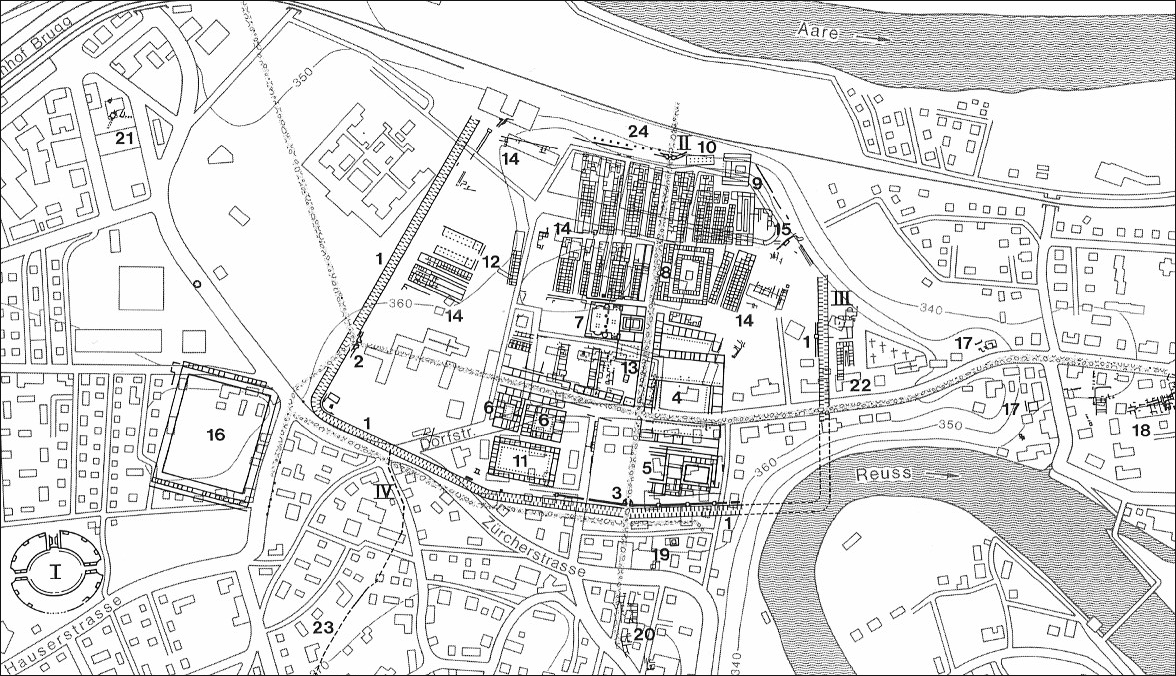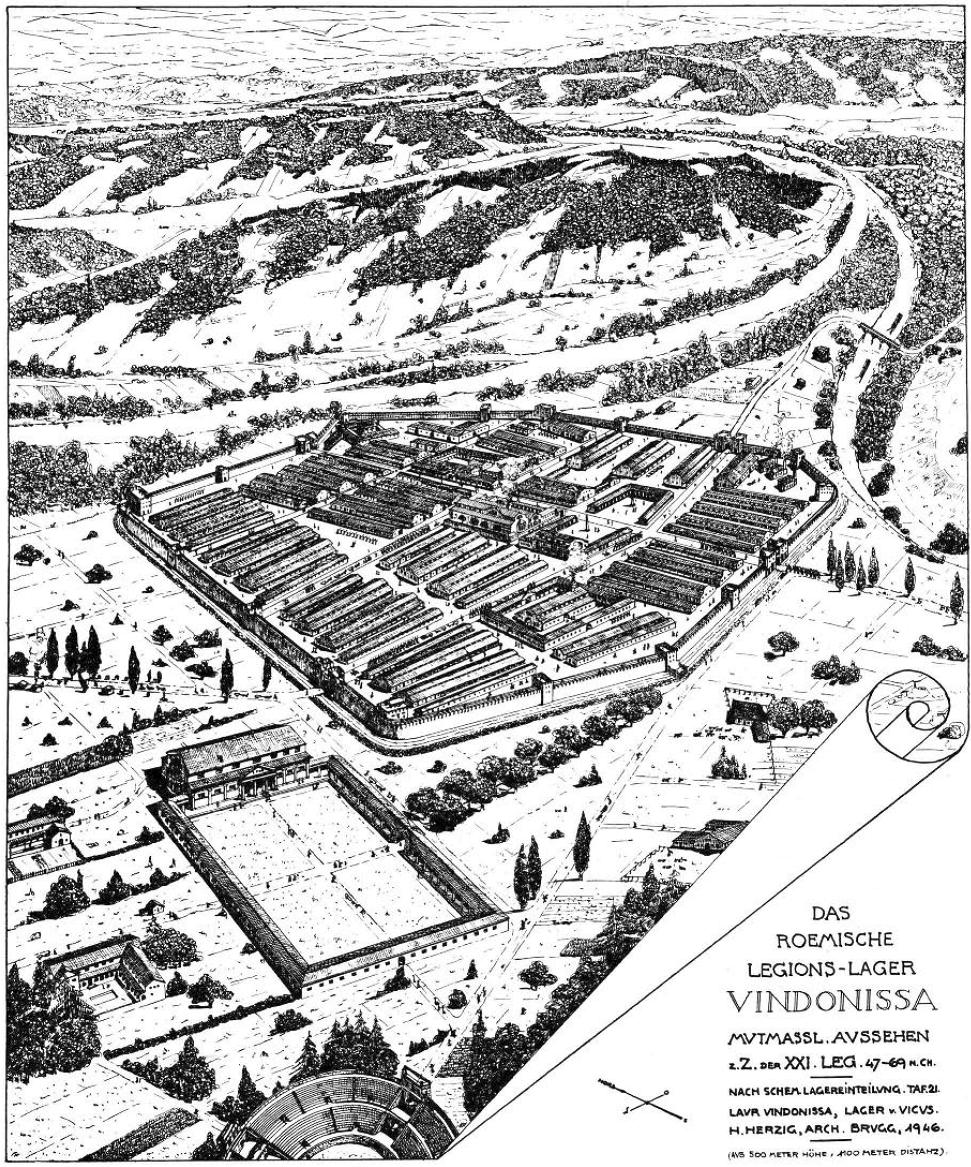|
Introduction Military headquarters and houses Baths and hospital |
Amphitheatre Temples The writing tablets |
Windisch, in antiquity called Vindonissa, is located immediately to the south of Brugg. It was an important Roman fortress, at the intersection of major roads, and at the confluence of the rivers Aare and Reuss, protected by these rivers. The camp was built in 16-17 AD on the spot of a Celtic fortification (oppidum), and used by Roman troops throughout the first century: by the 13th legion (until 45 AD), the 21st (45-69 AD), and the 11th (69-101 AD). It was used once more from the later third until the early fifth century. Outside the camp was a civilian settlement (canabae). Vindonissa is indicated on the Tabula Peutingeriana. The first discoveries were made already in the 15th century. Numerous investigations followed. Today most of the site is covered by modern buildings.

Windisch: camp and vicus at the end of the first century. Drack-Fellmann 1988, Abb. 501.
Visible remains
I: amphitheatre; II: north gate; III: baths; IV: water conduit.
Other remains
1: fortification wall; 2: west gate; 3: south gate; 4: headquarters (principia); 5: residence of the legion commander (praetorium); 6: houses of the military tribunes; 7: baths;
8: military hospital (valetudinarium); 9: arsenal; 10: grain warehouse (horreum); 11: warehouse with a courtyard; 12: halls; 13: temple of Mars; 14: barracks; 15: stables;
16: parade ground (campus); 17: temple; 18: civilian settlement; 19: temple; 20-21: civilian settlement; 22: inn (mansio); 23; water conduit; 24: rubble mound.The camp is mentioned by Tacitus, describing events in 70 AD:
Cohortium alarum legionum hiberna subversa cremataque, iis tantum relictis quae Mogontiaci ac Vindonissae sita sunt. The winter camps of the legions and of the auxiliary infantry and cavalry were all dismantled and burnt, with the sole exception of those at Mainz and Vindonissa. Tacitus, Histories 4,61. Translation W. Hamilton Fyfe. It has been argued that the camp was visited by Trajan in 98 AD. Much later Vindonissa is mentioned in a panegyric for Constantine from 310 AD. The camp featured in a battle with the Alemanni in 302 AD, in which Constantius I, father of Constantine, was victorious:
Te enim tantus ille et Imperator in terris et in caelo deus in primo aetatis suae flore generavit toto adhuc corpore vigens, illa praedito alacritate ac fortitudine quam bella plurima, praecipue campi videre Vindonissae.
Quid (commemorem) Vindonissae campos hostium strage completos et adhuc ossibus opertos?You were conceived by that great Emperor on earth and God in heaven in the first flower of his life, when he was still in full vitality and freshness, distinguished by that energy and vigor that has witnessed so many wars and especially the battlefields of Vindonissa.
Why (should I recall to memory) the battlefields of Vindonissa, strewn with mountains of fallen enemies and still covered with their bones today?Panegyrici Latini VI[7],4,2; VI[7],6,3. Translation after Frei Stolba 2013. Note that "Vindonissae" in the first quote is a suggested correction of the corrupt manuscript, which has "videris idonei".
"Vindonii" has also been suggested, as a presumed but otherwise unknown adjective, meaning "of Vindonissa".

Introduction
Military headquarters and houses
Baths and hospitalAmphitheatre
Temples
The writing tablets
Literature
Heuberger 1909; Laur-Belart 1931; Stähelin 1931, 573-584; Simonett 1937; Kielholz 1947; Von Gonzenbach 1961, 227-232; Wiedemer 1967(2); Laur-Belart 1969; Hartmann 1980(4); Hartmann-Weber 1985, 207-212; Drack-Fellmann 1988, 537-550; Drack-Fellmann 1991, 277-283; Speidel 1996; Frei-Stolba - Trumm 2007; Frei-Stolba 2009; Lawrence 2009; Trumm 2010; Trumm 2011; Maise - Pauli-Gabi 2012; Frei-Stolba 2013; Trumm 2013; Lawrence 2018; Lawrence 2019; Trumm-Flück-Schwarz 2022.
[8-Oct-2023]